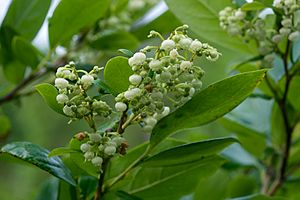Maleberry facts for kids
Quick facts for kids Maleberry |
|
|---|---|
 |
|
| Conservation status | |
| Scientific classification | |
| Genus: |
Lyonia (plant)
|
| Species: |
ligustrina
|
Lyonia ligustrina is a cool plant known by its common names, maleberry and he-huckleberry. It's a type of flowering plant that belongs to the Ericaceae family. This family also includes popular plants like blueberries and cranberries! You can find maleberry growing naturally across the eastern United States. It stretches all the way from Maine down to Florida, and west to states like Texas and Oklahoma.
Contents
What is Maleberry?
Maleberry is a type of shrub. This means it's a woody plant that's smaller than a tree. It can grow quite tall, reaching up to 4 meters (about 13 feet) high. Imagine a plant that can be taller than a basketball hoop!
How Does it Grow?
Maleberry has special underground stems called rhizomes. These rhizomes are like hidden runners that spread out. New stems can pop up from these rhizomes, sometimes as far as 4 meters away from the original plant. This helps the plant spread and create new patches. The bark on its stems has cool grooves or furrows running along them.
What Do Its Leaves and Flowers Look Like?
The leaves of the maleberry plant are oval-shaped. They can be up to 10.5 centimeters (about 4 inches) long and 5 centimeters (about 2 inches) wide. Depending on the specific type, its leaves might fall off in the autumn (deciduous) or stay green all year. The plant produces small, white flowers. After the flowers, it grows a small, dry fruit called a capsule.
Where Does Maleberry Live?
This plant is very common and can be found in many different places. It likes a variety of habitats, including:
- Savannas: These are grasslands with scattered trees.
- Bogs: Wet, spongy areas, often with moss.
- Forests: Areas with lots of trees.
- Pocosins: A type of wetland found in the southeastern U.S.
- Swamps: Wet areas with trees and water.
Maleberry often grows in "ecotones." These are special areas where two different habitats meet, like where a forest meets a swamp. It can grow in both very wet and very dry places, showing how tough it is!
Why is it Called Maleberry?
The common names "maleberry" and "he-huckleberry" are quite interesting! They come from the fact that this plant produces hard, dry capsules. These capsules are not like the soft, juicy, and edible fruits you find on other plants in the same family, such as huckleberries and blueberries. Because its fruit isn't soft and sweet, people thought of it as a "male" version, not producing the "feminine" juicy berries.
How Does Maleberry Survive Fires?
Maleberry is super tough when it comes to fire. It can handle fires really well! If the parts of the plant above ground burn away, its underground rhizomes are usually safe. They can then send up new shoots and stems, helping the plant grow back quickly. This is why you often find maleberry in places that experience fires often, like pine barrens. Pine barrens are areas with sandy soil and pine trees that are naturally prone to wildfires.


